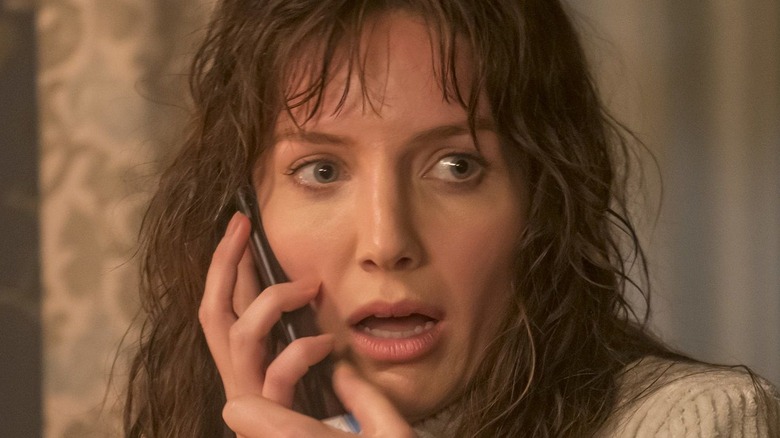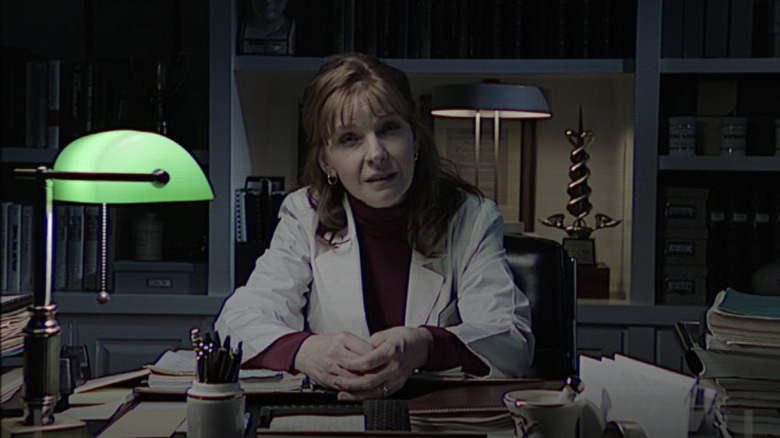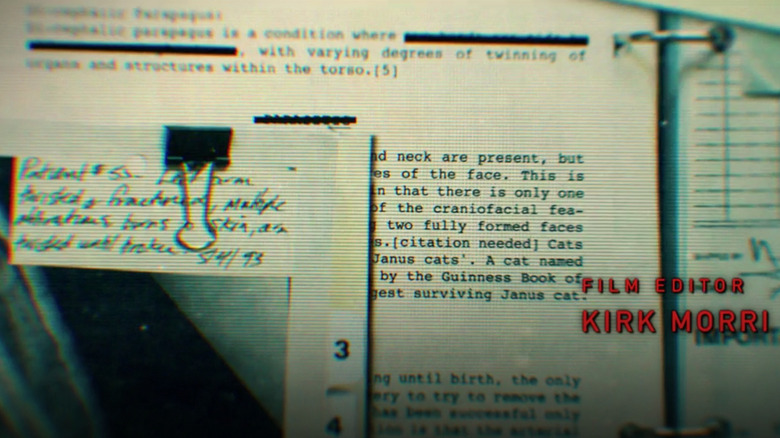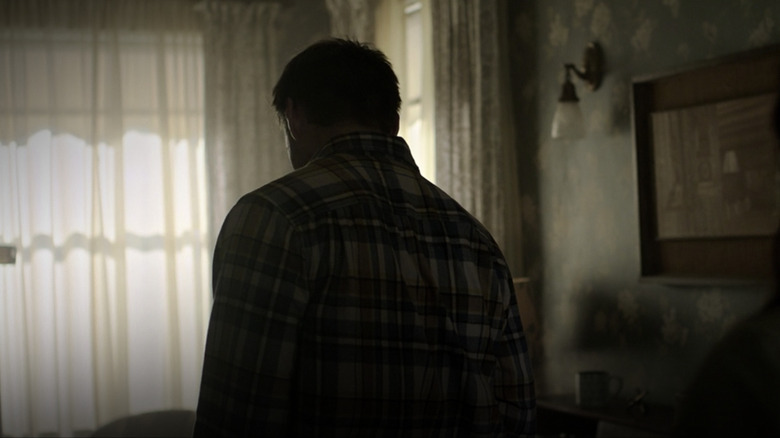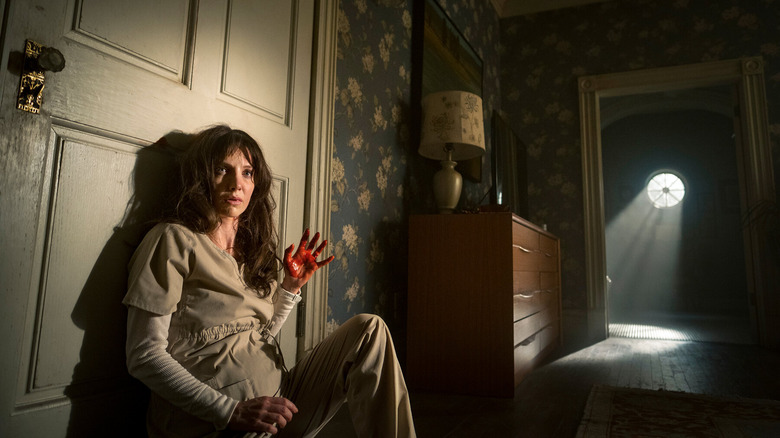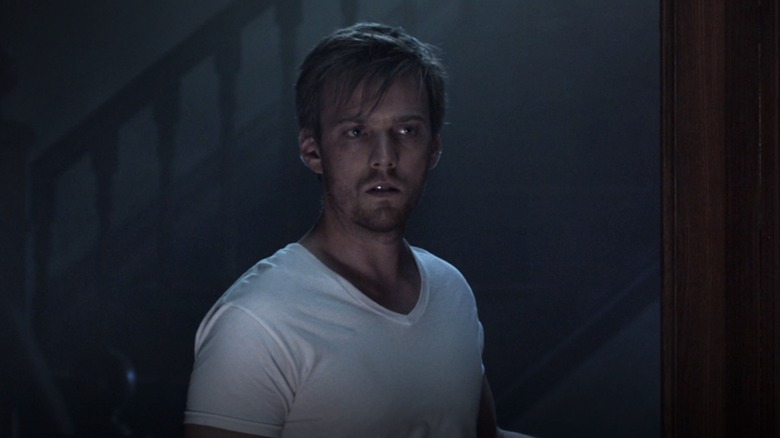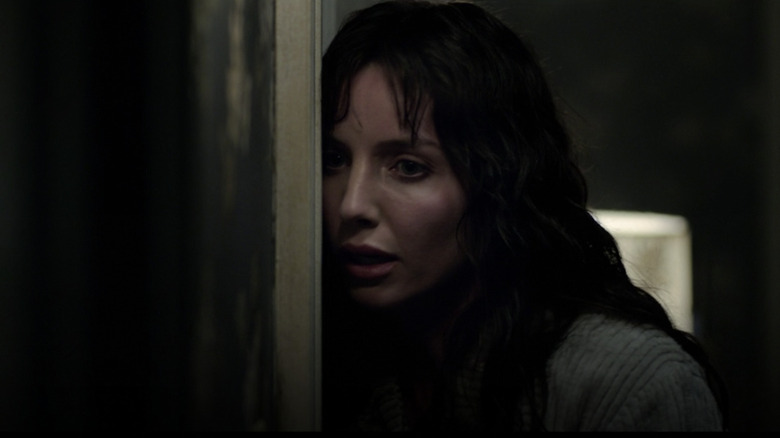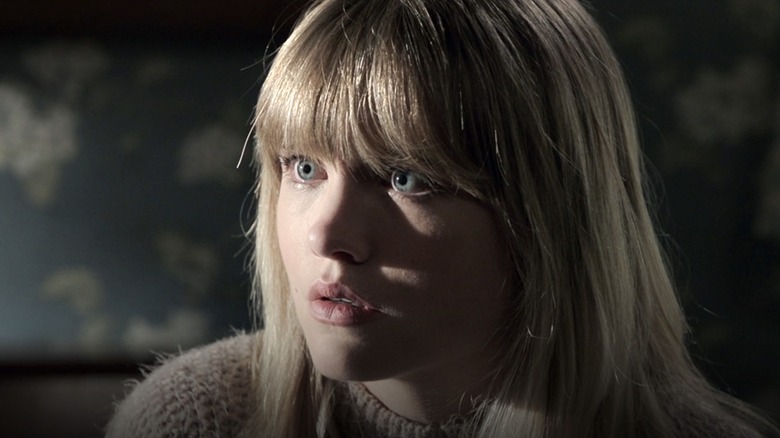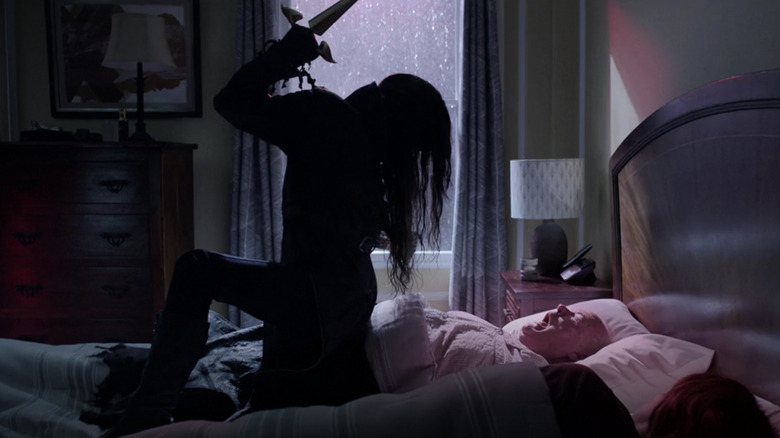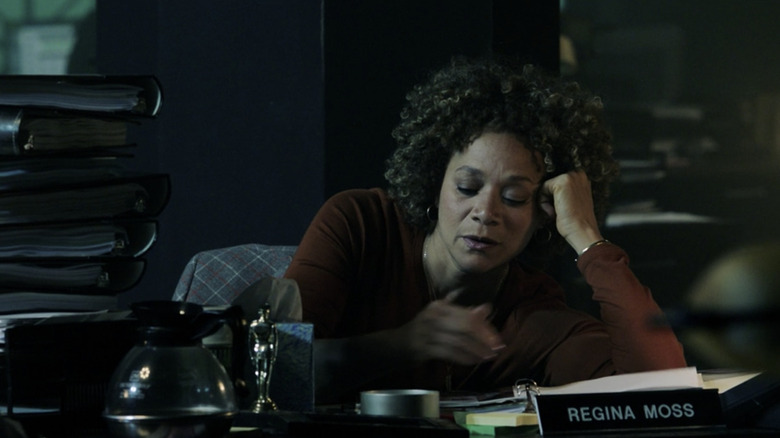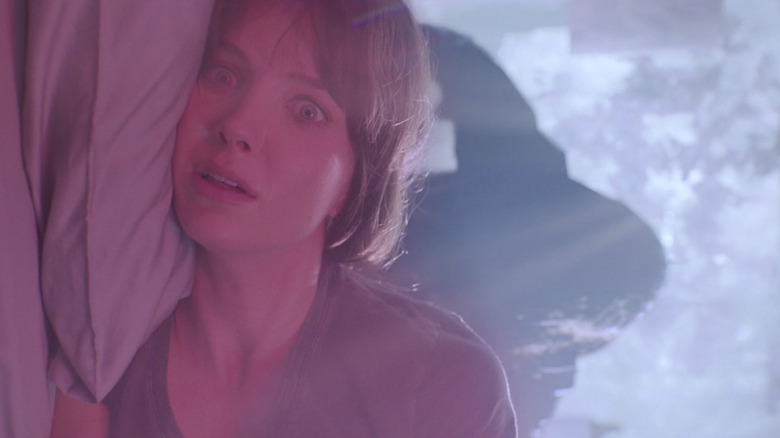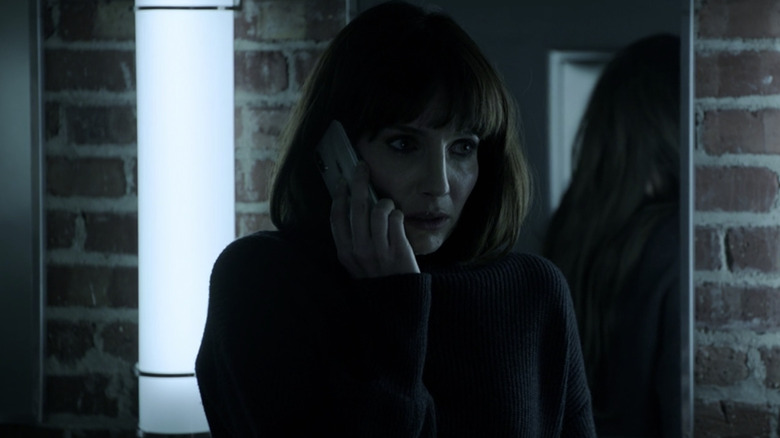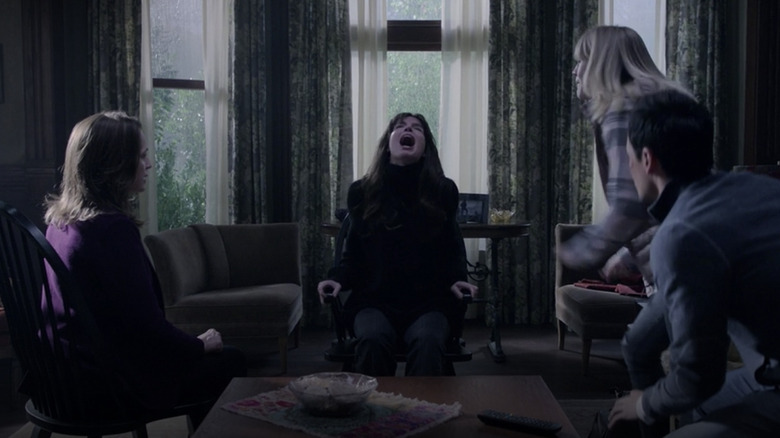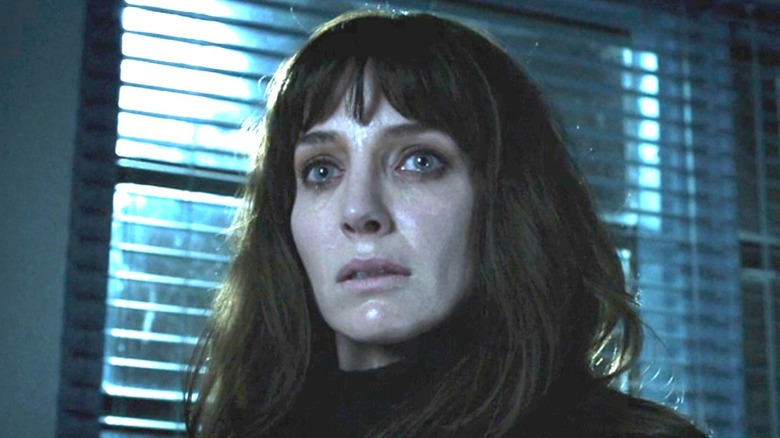Things You Only Notice In Malignant After Watching It More Than Once
If you've already seen James Wan's mind-bending 2021 horror splatterfest "Malignant," then you know all is definitely not as it appears in the film, which follows a woman named Madison (Annabelle Wallis) who starts experiencing visions of brutal murders committed by a malevolent entity known only as Gabriel. Of course, once Gabriel's true nature is revealed by the end of the film, it's clear that "Malignant" has been toying with its audience the whole time, dangling clues that we didn't realize were clues right from the very beginning of the movie. It's enough to make you want to immediately start the film over, to see what you missed the first time.
While some sharp-eyed viewers may catch some of the subtle clues and foreshadowing Wan seeds throughout "Malignant" the first time around, most will notice at least a few cleverly hidden-in-plain-sight treats upon a second viewing. Here are some of the most interesting things we noticed after watching "Malignant" more than once.
[Warning: major spoilers ahead]
The murder weapon is in the opening shot
Once you get past the studio logos and the exterior establishing image of Simion Research Hospital, the first scene of "Malignant" takes place in the office of Dr. Florence Weaver (Jacqueline McKenzie), who is recording a video journal about her ongoing treatment of Gabriel (whom we will later learn is Madison's psychopathic parasitic twin). In the background of the shot, on one of Dr. Weaver's office shelves, we can see a trophy prominently displayed that looks like a knife with wings. Later, we get a better look at this trophy, and see it is an award for excellence in surgery presented to Dr. Weaver by the Northwest Medical Research Association.
Of course, that trophy becomes very significant once Gabriel's killing rampage starts after Madison grows up. After bludgeoning Dr. Weaver to death with it, he steals it from her house, removes the base and some embellishments, and sharpens the blade. This becomes Gabriel's weapon of choice for his subsequent murders, making it ironic that the award Dr. Weaver received for her ability to cut out her patients' maladies was precisely the thing used by one of those maladies to seek its vengeance.
The entire twist is in the opening credits
Following "Malignant's" violent opening scene, the film then has a credits sequence more reminiscent of '90s television shows and action movies than modern-day horror. While viewers likely won't be able to make much sense of the quick imagery that flashes by behind the names of the cast and crew, Wan actually has hidden most of the film's secrets right in plain sight. The credits scroll through images of dividing cells, surgical procedures, brain scans, and patient files.
Those files not only show a picture of young Emily May — Madison's name before her adopted parents changed it — but also make note of a patient with "co-existing... bi-mental/physical... bodily functions." Sounds a lot like how Gabriel and Madison are able to share a brain and body, yet function separately from each other. It also talks about a patient "sleep walking," and experiencing "hallucinations" and "waking dreams," which is what later happens to Madison when Gabriel takes over her body. What's more, there's even a blink-and-you-miss-it shot of a creature poking out from the back of a hospital gown worn by someone with long brown hair, and a few brief close-up shots of Gabriel's malformed face. Plus there is research on something called a "Janus cat," which is a cat born with two faces. Add it all up, and you basically get the entire plot of "Malignant" right in the movie's first couple of minutes.
Talking to the back of her husband's head
Gabriel's first kill in the present-day timeline is Madison's abusive husband, Derek (Jake Abel). Derek is upset that his wife, whom he and those closest to her call Maddie, continues to experience miscarriages, yet in his mind, isn't taking enough precautions to prevent more. When Maddie comes home early from work with abdominal pain, Derek begins to get angry, and Maddie quietly tells him, "You can't keep doing this." That seems to only anger Derek more, and he smashes her head against the wall — awakening Gabriel, who almost immediately turns on Derek.
However, once you know what's about to happen and who Gabriel is, Maddie's line — along with how she delivers it — seems to carry some additional meaning. When she says it, she's talking to the back of Derek's head, after he turns away from her to face the bed. Although she's talking about Derek's reaction to her miscarriages, it feels different when we later learn that Gabriel is the one who has been causing those miscarriages. Madison telling the back of a man's head, "You can't keep doing this," in regard to her losing her babies, definitely gains some additional meaning when you know that there's a man living in the back of her own head who keeps causing those losses.
If you or someone you know is dealing with domestic abuse, you can call the National Domestic Violence Hotline at 1−800−799−7233. You can also find more information, resources, and support at their website.
'That's not me'
The hits just keep on coming (literally) when it comes to Derek's confrontation with Maddie. After he smashes her head into the wall, he suddenly seems remorseful, and runs out of the bedroom to go find some ice for the injury he just caused. But this appears to not be Maddie's first rodeo, and she immediately locks him out of the room, leaving a bloody streak from her open head wound (which we later learn is how Gabriel is unleashed into the world) as she slides down the door.
Once Derek realizes Maddie has locked him out, he pleads with his wife to unlock the door, not realizing she has her back to him. "That's not me," he says, trying to reassure her through the door — to no avail — that the violence he just exhibited was uncharacteristic of him. The one-way conversation between them, with one person speaking to Maddie's back and insisting that the violent person who inflicted such harm is "not me," is yet another way that Maddie's initial confrontation with Derek hints at bigger themes yet to come.
Derek's death is a mirror for Gabriel
Pretty much everything about Derek's interactions with Maddie and Gabriel is symbolic of what eventually happens in the rest of the film, including the gruesome way Derek dies. While we don't see the murder itself, with the scene ending the second Gabriel begins to attack, we do see how Maddie finds him later, with his head twisted completely around to face his back. When detectives Shaw (George Young) and Moss (Michole Briana White) arrive to investigate Derek's murder, crime scene technician Winnie (Ingrid Bisu) tells them that she's "never seen anything quite like it."
While that may be initially true for Winnie, she (and the rest of the police department) will see a sight very similar to that later on in the film, when Gabriel — by then, obviously an entity protruding out of the rear of Maddie's own head — attacks the police precinct. Of course, Gabriel's face comes out of the back of Maddie's skull, so no twisting is required, but the position of Derek's corpse, with his face pointing the wrong way in relation to his body, still seems like Gabriel is almost toying with the police and the audience, telling them (and us) exactly how he operates without anyone realizing it.
It's all in Maddie's head -- or is it?
After Gabriel awakens within Maddie, thanks to Derek's domestic violence alarm clock, he decides to toy with Maddie for a bit before embarking on his murder spree. When she returns home from the hospital, she thinks she sees him standing underneath a street light outside her window. Of course, later we realize that it must have been a mental projection from Gabriel, similar to how he always made her think she was safe in her house when murders were being committed across town. But at the time, a terrified Maddie assumes she must be hallucinating as a symptom of PTSD. "It's all in my head," she repeats to herself over and over after locking herself in her bedroom.
Seems reasonable, until the final twist of the film reveals that Gabriel is literally a physical being that emerges from within Maddie's head. So on the one hand, she's exactly right that the shadowy, menacing figure that she saw is, in fact, all in her head. But on the other hand, she's extremely wrong when she tries to tell herself, "It's not real," since Gabriel is much more real than anyone in the film would like him to be.
A musical Easter egg
It's not unusual for movie villains to get their own musical themes, and Gabriel is no exception. Yet while "Malignant" has its own original score composed by long-time Wan collaborator Joseph Bishara, the song that accompanies some of Gabriel's biggest moments — including one we don't even realize is associated with Gabriel until later — is not an original piece at all. It's a cover of the Pixies' 1988 hit "Where Is My Mind?," which was also notably used during the climax of "Fight Club," when antagonist Tyler Durden (Brad Pitt) and the Narrator (Edward Norton) are revealed to be one and the same character. The cover version used in "Malignant" was released in 2018 by Safari Riot featuring Grayson Sanders.
"Malignant" never incorporates the lyrics to the song, although the title is enough to make the relevance obvious. However, some of the lyrics definitely feel pretty on-the-nose, such as, "With your feet on the air and your head on the ground/ Try this trick and spin it, yeah/ Your head will collapse, and there's nothing in it/ And you'll ask yourself/ Where is my mind?" In "Malignant," the police observe early on that Gabriel's handprints on Derek's body make it seem as though he was upside down when committing the murder, and we later see him dropping from the ceiling onto Detective Shaw. Of course, Madison spends much of the movie with Gabriel overriding her consciousness (emptying her head, in a sense) and taking her body on a joy ride. That makes the question posed by the song a literal one, since Maddie spends much of the film having no idea where her brain is or what it's doing.
Gabriel is always moving backwards
Even first-time viewers will surely notice that Gabriel's movements seem a little bizarre and inhuman, but many won't realize until the end of the film exactly why he looks so disconcerting. It's because he's moving backwards all the time, bending his arms, legs, and torso in ways most of us can't, and wearing a trench coat and hood over Madison's front to present the illusion of the back half of her body being the front half of his.
Wan and his wife and co-writer Ingrid Bisu visualized the adult Gabriel not through special effects, but through real humans with a very unique skill set. Most of Gabriel's movements are performed by contortionist Marina Mazepa, who learned and performed most of her scenes backwards with an Annabelle Wallis mask on her face. In other scenes, Gabriel's movements were performed by frequent horror contortionist Troy James. So although Gabriel's movements in some scenes may seem impossible for a real human body to execute, it turns out that all of his bizarre and unsettling movements are in fact possible, as long as you're very, very flexible.
Brains and eyeballs
After Gabriel kills Dr. Weaver, Detective Kekoa Shaw and his partner, Detective Regina Moss, take Dr. Weaver's extensive collection of medical files back to their offices to study, in the hopes of uncovering a worthy lead. But the stacks of files prove to be a pretty daunting reading assignment; Regina eventually declares herself done for the night, saying that if she has to read about any more sick children, "my brain's going to push out my eyeballs."
Of course, Regina doesn't mean this literally, but not long after that, we discover that Gabriel (and his host, Maddie/Emily) was himself one of those sick kids. What's more, when Gabriel takes over Maddie's body, his eyeballs literally push out through Maddie's brain, a disgusting yet surprisingly accurate mirror image of the metaphor that Regina used to talk about the experience of reading all those files — including, most likely, that of Gabriel himself.
Eyes in the back of her head
As "Malignant" proceeds, it seems almost as though Gabriel gets a little cheeky with the visions he gives Madison. When he kills Derek, he seems to go out of his way to make Maddie believe he's a totally different person from her, even going so far as to give her a vision of him chasing her through the house. But by the time he's gotten to poor Dr. Fields (Christian Clemenson), he's become more bold, making Madison feel like she's in the same bed as his target (spoiler: she is), and appearing to rise up from behind her in a shot that looks almost as if he's emerging from the back of her head.
Of course, as we later learn, Gabriel is literally emerging from the back of Maddie's head, making the vision he gives her very close to what is actually happening. He comes as close to tipping his hand as possible without actually clueing her into what is going on, dancing all around the outline of the reveal but never quite filling it in. It's like he's playing a twisted game with her, seeing if he can get her to guess his riddle. But of course, the problem is that Maddie isn't aware that she's even playing, and Gabriel's game is no fun at all.
Mirror, mirror
When Maddie witnesses Gabriel's third murder, in which he killed Dr. Fields, she and Sydney head to the police station to report the weird things they know. Of course, Detectives Shaw and Moss don't believe that Maddie is actually receiving psychic visions of the killings, because it sounds completely ludicrous, but they still follow her lead and discover she was right. However, when Maddie tries to describe Gabriel to the sketch artist, the resulting image looks, in the words of Detective Moss, like "Sloth from 'The Goonies.'"
Maddie heads to the bathroom to collect herself, unsure what to make of her bizarrely unsettling situation, only to have her phone ring with a call from Gabriel himself. Little does she know that he's using his abilities to manipulate speakers and electricity to place the call from within her own head. However, upon rewatch, viewers will notice that throughout the call, while Maddie's face is centered in the shot, the back of her head is also visible in the mirror behind her. It's yet another visual clue that while it seems to Maddie as though she's carrying on a conversation with a totally separate person, she's actually talking to the one that lives in the back of her head.
Her hair is full of secrets
After Madison recovers her lost memories, she remembers that Gabriel tried to manipulate her as a child into killing her younger sister, Sydney (Maddie Hasson). She assumes that Gabriel thought that if Maddie had a new sibling, she wouldn't need him anymore — and he was right. Sydney's birth gave Maddie the strength to banish Gabriel from her mind, turning him into "a lost memory, buried deep in the back of my head."
It's probably become evident by now that "Malignant" is chock full of wordplay that becomes pretty obvious upon rewatch, and this line is no different. But rather than the metaphorical way Maddie intends it, her line about Gabriel being "buried deep in the back of [her] head" turns out to be entirely literal. When Dr. Weaver and the other surgeons performed the surgery to separate Maddie from Gabriel, they couldn't completely remove Gabriel without killing Maddie, so they literally stuffed him into the back of her skull like a demonic piñata. Yet again, Maddie is putting into words exactly what is going on, but everyone listening — including the audience — isn't yet capable of comprehending it.
Maddie could use a nap
As "Malignant" progresses, Maddie gradually begins to look more and more exhausted, with her eyes hollowing and her skin turning pale and clammy. First-time viewers will likely attribute this to the growing stress of dealing with the macabre mystery of Gabriel's killings, but multiple watches may tune viewers into another explanation for Maddie's increasingly haggard appearance — she's not sleeping.
Yes, we see Maddie go to bed at numerous points during the film, but in order for Gabriel to be able to carry out his many nefarious acts, it seems that a lot of the time that Maddie believes she's sleeping is actually waking time for Gabriel. After all, she only is aware of his consciousness when he's committing murders, but that doesn't account for all the time he spends skulking around in her attic or abducting their birth mother. Most likely, Gabriel often leads Maddie to believe she's sleeping while he's awake, meaning that her body is getting very little, if any, rest. No wonder they're both cranky.
